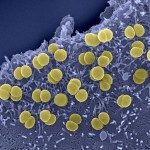Présentation
The molecular basis of the meningococcal pathogenesis is under active exploration by several groups in the world. Full genome sequencing failed to reveal specific determinants that could discriminate between transmissibility and non offending colonisation by some strains (carriage strains) and invasive infection upon acquisition of the so-called hyperinvasive strains. In fact, there is accumulating evidence for the existence of different bacterial populations that can be identified by molecular typing, and whose genetic homogeneity correlates with their virulence and cytopathic properties. There is increasing evidence that invasive meningococcal infections provoke cytopathic effects in infected cells. These observations are consistent with the extensive cell injury and tissue damage seen in autopsy material from cases of human disease. We have first shown that unlike carriage isolates, a strong association of cytopathic effect to epithelial cells was observed with isolates belonging to the hyper-invasive clonal complex ST-11. Infected cells presented features of apoptosis. The apoptotic pathway induced by these isolates is mediated in part by lipooligosaccharides (LOS), the major bacterial endotoxin, and involved tumor necrosis factor alpha (TNF-a) signaling through its cognate receptor TNFR1. In contrast, carriage isolates interfered with TNF-a-dependent apoptotic signaling by increasing extracellular shedding of TNFR1 leading to attenuation of the biological activity of TNF-a. We also showed that meningococcal outer membrane protein, PorB, acts independently but synergistically with LOS to induce apoptosis (Deghmane et al., 2009). These cytopathic effects are polygenic, involve major surface determinants evoked above, such as LOS, PorB and most likely other structures. Nevertheless, our results provide important mechanistic insights to discriminate between carriage and invasive strains, hence opening towards new approaches for the specific control of meningococcal disease-causing strains. Our data strongly suggest that carriage isolates of meningococci have co-evolved with human in a manner to reduce inflammatory response and apoptosis induction resulting in the protection of their ecological niche at the human nasopharynx.


